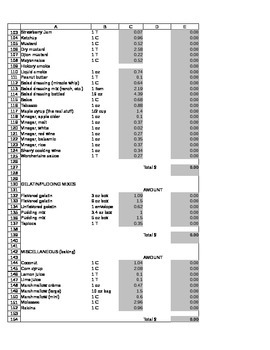Food Costing Sheet
- XLSX
- Google Apps™

Description
Teaching students how to cost out food is valuable--but what if you just need to quickly cost out food for yet another catering job or shopping spree for a food lab?
Some school districts now require teachers to itemize their costs even before stepping into the store. Who has time to gather all those numbers on an online store first? With this handy Excel file, you can quickly punch in the amount of each food item/ingredient and it will compute it for you!
NEW: Google Sheets version is linked on the excel sheet for you to copy.
Items are organized and you can easily enter in what you need for a recipe or catering order. Most prices are already entered for retail price. Some areas of the country, however, have slightly higher or lower prices. You may want to update these prices as you see fit (or ask students to update by printing out a page for them to mark up next time they're at the store!). Please note that meat prices are all now included--these prices vary greatly depending on location, cut, and time of year. I suggest that you double-check these prices at your local store for the most accurate prices.
I took a few days before school started and updated my files (current as of October 2021 with a small update in June 2022 and will be updated every so often). I've found this incredibly helpful in my culinary and foods classes. I don't have extra time to guesstimate how much I need to charge for an event--this ensures I'm not losing money. Students can also learn to use this file within one class period and soon they'll be doing this each and every time!!!
Recently added 3 more tabs that will help calculate food cost % to a customer paid price (30%, 44%, and 50% food cost). Easy to edit and create your own percent cost.
This file is also great if you have a large family or want to help your child learn how to manage money at the grocery store.



